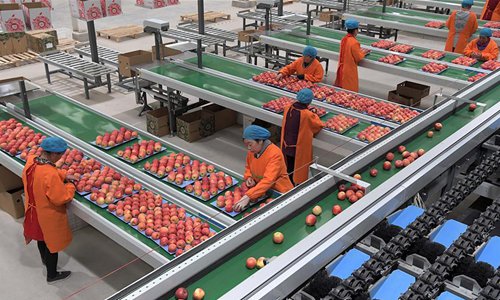
Workers pick apples at a company in Luoning County, Central China's Henan Province, Oct. 29, 2019. In recent years, the government of Luoning County has strengthened poverty alleviation efforts by increasing investment and developing different industries of planting and animal breeding. Companies also join in poverty relief work by offering working opportunities for impoverished people in workshops. Photo: Xinhua
China has witnessed an increase in the number of private enterprises in the past five years, but the development of foreign-invested enterprises has slowed down, a report released by the National Bureau of Statistics (NBS) said on Friday.
The report said there were 2.9 million private enterprises at the end of 2018, an increase of 65.4 percent since 2013, with total assets worth 40.5 trillion yuan, a growth of 48.6 percent.
However, the increase in the number of foreign-invested enterprises has slowed down. There were 44,000 foreign-invested industrial enterprises nationwide at the end of 2018, a decline of 1.2 percent in terms of the portion in total industrial enterprises since 2013.
NBS attributed this to the weakening of preferential policies, rising labor costs, and increasing competitiveness from domestic-funded enterprises.
But NBS said the total assets of foreign-invested enterprises continue to rise, with total assets of 13.4 trillion yuan ($1.91 trillion) at the end of 2018, or 7.4 percent higher than in 2013.
The State Council in November issued a guideline on maximizing the use of foreign investment, with a focus on safeguarding the treatment of foreign-funded enterprises. The guideline puts forward 20 policies in four aspects to create a more "fair, transparent and predictable" business environment for foreign investors.
To deepen opening-up, China will continue to reduce the negative lists for foreign investment access in pilot free trade zones and the rest of the country, and comprehensively eliminate restrictions not included in the negative lists, the guideline said.
NBS also said the distribution of employees among industries has seen positive changes, gradually shifting from traditional raw material manufacturing and high energy-consuming industries to advanced manufacturing, although the number of industrial employees has generally declined.
The proportion of employees in the raw material manufacturing and energy-intensive manufacturing industries dropped by 2.4 and 2.1 percentage points, respectively, at the end of 2018, compared to 2013, NBS said, while the proportion of the equipment manufacturing industry increased by 4.8 percentage points, reflecting the transformation and upgrade of manufacturing.
